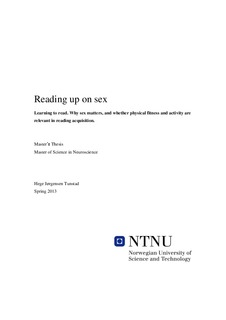| dc.description.abstract | When you read this thesis, you rely on a skill you acquired as a child. Most children start at the age of 5-6 years to learn single letters, write their name, and gradually develop the functional skill of decoding strings of letters; in other words, reading. By the age of 10 they are expected to read texts with concentration, endurance, fluency and coherence. The success rate varies, and Norwegian children score slightly above average when reading skills are measured globally, and are better at simple decoding, although worse at interpreting and evaluating text. Also, there is a strong trend towards girls outperforming boys at reading at this age. The demands on reading skills are growing with increasing cognitive demands put on the workforce in the Information Age. Basic skills such as reading, writing and mathematics are deemed crucial to later work life by the Norwegian Government.
So how can we further pave the way for literacy? The Norwegian Directorate for Education and Training states that "fysisk aktivitet indirekte fører til bedre prestasjoner i for eksempel matematikk og språkfag." (physical activity can indirectly lead to better performance in for instance mathematics and languages). We set out to test if boys and girls are different, and to see whether there is in fact a "spillover effect" from physical activity to reading skill in 9- and 10-year-old Norwegian children. We confirmed girls’ superiority in reading. Moreover, we saw the rudimentaries of fitness effect on girls’ reading skills (0.404, p=0.027), but not for boys.
Our results show that sports cannot simply be used as a means to improve academic achievement. However, because sports have health benefits, we by no means suggest that sports should be removed from the school curriculum. We would like schools to devote additional hours to training students in the technical aspects of reading, because one needs to train in the skill itself to become good at it. Given the sex differences at this age, reading training may be improved by choosing teaching methods that take into account the differences in boys’ and girls’ neural development. Both boys and girls will benefit from beginning with phonetic reading training, after which they should be exposed to mixed methods as their reading skills improve. Boys will suffer, however, if they do not begin to read by first starting with the phonetic method. | nb_NO |
